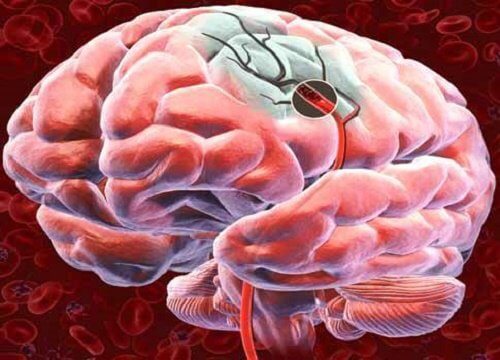Five Ways to Increase Blood Flow to Your Brain


Written and verified by psychologist Valeria Sabater
Cerebral blood flow is the supply of blood that reaches your brain. According to a publication from the National Center for Biotechnology Information, your brain needs nearly 20 percent of the available oxygen to function normally. This means that strict regulation of blood flow and oxygen supply is essential for its survival.
Among other things, cerebral blood flow is important for transporting glucose and other important nutrients to the brain. Consequently, you need it to function properly and stay healthy. Therefore, it’s interesting to know that certain habits favor the flow of blood to the brain.
In fact, as daily practices, and part of a healthy lifestyle, these habits can protect your brain and help prevent illnesses associated with bad circulation. Not only that, but they’re a great way to stay active and full of energy.
You might also like to read: Improve Blood Circulation with Natural Remedies
How to increase blood flow to your brain
To understand how these habits can help the flow of blood to your brain, it’s important to understand what the risk factors are that affect its proper functioning. According to a study conducted by the American Association of Neurological Surgeons, bad habits like smoking and a sedentary lifestyle contribute to this problem.
It’s also associated with high blood pressure, diabetes, arterial disease, high cholesterol, and other illnesses that are associated with an unhealthy lifestyle. So let’s take a look at some habits to increase blood flow to your brain.
1. Aerobic exercise

So-called aerobic exercises can increase your cardiovascular function and, thereby, also increase blood flow to your brain. In fact, a study published in Artery Research found that aerobic exercise increases cerebral blood flow. It also decreases cerebrovascular resistance in postmenopausal women.
This study concluded that regular aerobic exercise can mitigate the decrease in cerebral blood flow due to aging.
You can choose any of the following simple activities or combine them:
- Walk every day for half an hour.
- Run every day for 15 minutes.
- Take dance classes.
- Go for a bike ride for 15 minutes.
- Do aerobic exercises at home.
2. The best foods to increase blood flow to your brain
According to a study published in Nature Reviews Neuroscience, nutrition plays an extremely important role in brain health and cognitive function. For this reason, it’s a good idea to increase your consumption of foods that stimulate cerebral blood flow. For instance, those high in antioxidants, carbohydrates, proteins, and omega-3.
Some good options are:
- Eggs.
- Blueberries, strawberries, and citrus fruit.
- Whole grains like quinoa, brown rice, oats, barley, rye, etc.
- Essential fatty acids such as those found in salmon, sardines, avocados, olive oil, walnuts, and pumpkin seeds.
- Tomatoes, kale, broccoli, spinach, and asparagus, among others.
3. Avoid smoking, obesity, and stress

It’s vital that you keep in mind that smoking, being overweight, and stress are three of the greatest enemies of your brain health. A study conducted by the Journal of Pharmacological Sciences discovered that smoking cigarettes alter the increase of cerebral blood flow mediated by nitric oxide. At the same time, smoking has an impact on the progression of Alzheimer’s disease.
Being overweight or obese is also a risk factor for developing cerebrovascular illnesses. According to a study published in Clinical Autonomic Research, having a high body mass index is associated with a reduction in cerebral blood flow and a higher risk of suffering a stroke.
With regard to stress, a study published in Frontiers in Neuroscience found that it can affect cerebral vascular function. It can also increase the risk of various conditions related to your brain’s vascular system.
You might also be interested in: Discover How Smoking Affects the Heart
4. Do brain exercises every day
In order to increase the blood flow to your brain, you must also exercise its cognitive functions. For example, your memory, curiosity, and daily interests. This will establish new connections between your neurons and, gradually, will create more tissues and structures that are resistant to possible illnesses.
Therefore, don’t hesitate to learn new things every day. You can read, sign up for classes, and keep a diary and write down your thoughts. In fact, discover everything the world has to offer you to improve your memory and concentration.
5. The power of positive emotions

Daily stress, anxiety, or viewing things from a negative point of view can alter the neurochemistry of your brain, according to a study published in Neuropsychopharmacology. They cause fluctuations that threaten the blood flow to this vital organ.
On the other hand, positive emotions can have a beneficial effect. Not just in terms of cerebral blood flow, but also concerning cognitive function. So try and follow this advice:
- Maintain a sense of humor and talk about what makes you happy.
- Practice relaxation techniques such as yoga. This will help you to connect with yourself and live in the present.
- Develop your social relationships. Enjoy your friends and family… Don’t just sit at home!
Adopt a healthy lifestyle
As you can see, there are several healthy habits you can incorporate into your day-to-day life to help stimulate cerebral blood flow and reduce the risk of illness. These habits will also help you be more active and focused.
As always, if you have any doubts or think you might have an illness that could compromise the health of your brain, you should see your doctor immediately so you can get the necessary treatment.
All cited sources were thoroughly reviewed by our team to ensure their quality, reliability, currency, and validity. The bibliography of this article was considered reliable and of academic or scientific accuracy.
- Cipolla MJ. (2009). The Cerebral Circulation. San Rafael (CA): Morgan & Claypool Life Sciences; 2009. Chapter 5, Control of Cerebral Blood Flow. Available from: https://www.ncbi.nlm.nih.gov/books/NBK53082/
- Chapman, S. B., Aslan, S., Spence, J. S., DeFina, L. F., Keebler, M. W., Didehbani, N., & Lu, H. (2013). Shorter term aerobic exercise improves brain, cognition, and cardiovascular fitness in aging. Frontiers in Aging Neuroscience, 5(NOV). https://doi.org/10.3389/fnagi.2013.00075
- Gómez-Pinilla F. (2008). Brain foods: the effects of nutrients on brain function. Nat Rev Neurosci. 2008;9(7):568–578. doi:10.1038/nrn2421
- Fantini S, Sassaroli A, Tgavalekos KT, Kornbluth J. (2016). Cerebral blood flow and autoregulation: current measurement techniques and prospects for noninvasive optical methods. Neurophotonics. 2016;3(3):031411. doi:10.1117/1.NPh.3.3.031411
- Díaz-Carrillo, M. A., & Carrillo-Esper, R. (2015). Flujo sanguíneo cerebral. Revista d Mexicana de Anestesiología.
- Mellendijk L, Wiesmann M, Kiliaan AJ. (2015). Impact of Nutrition on Cerebral Circulation and Cognition in the Metabolic Syndrome. Nutrients. 2015;7(11):9416–9439. Published 2015 Nov 13. doi:10.3390/nu7115477
- Toda, N., & Okamura, T. (2016, August 1). Cigarette smoking impairs nitric oxide-mediated cerebral blood flow increase: Implications for Alzheimer’s disease. Journal of Pharmacological Sciences. Japanese Pharmacological Society. https://doi.org/10.1016/j.jphs.2016.07.001
- Selim, M., Jones, R., Novak, P., Zhao, P., & Novak, V. (2008). The effects of body mass index on cerebral blood flow velocity. Clinical Autonomic Research, 18(6), 331–338. https://doi.org/10.1007/s10286-008-0490-z
- Lee, S., Kang, B. M., Shin, M. K., Min, J., Heo, C., Lee, Y., … Suh, M. (2015). Chronic stress decreases cerebrovascular responses during rat hindlimb electrical stimulation. Frontiers in Neuroscience, 9(DEC). https://doi.org/10.3389/fnins.2015.00462
- Northey, J. M., Cherbuin, N., Pumpa, K. L., Smee, D. J., & Rattray, B. (2018, February 1). Exercise interventions for cognitive function in adults older than 50: A systematic review with meta-Analysis. British Journal of Sports Medicine. BMJ Publishing Group. https://doi.org/10.1136/bjsports-2016-096587
- Shin LM, Liberzon I. (2010). The neurocircuitry of fear, stress, and anxiety disorders. Neuropsychopharmacology. 2010;35(1):169–191. doi:10.1038/npp.2009.83
This text is provided for informational purposes only and does not replace consultation with a professional. If in doubt, consult your specialist.








